|
|
|
Sort Order |
|
|
|
Items / Page
|
|
|
|
|
|
|
| Srl | Item |
| 1 |
ID:
086467
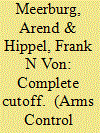

|
|
|
|
|
| Publication |
2009.
|
| Summary/Abstract |
President Barack Obama has pledged to "lead a global effort to negotiate a verifiable treaty ending the production of fissile materials for weapons purposes."[1] Fissile materials are the chain-reacting fissionable materials that are the essential ingredients in nuclear weapons, in practice, highly enriched uranium (HEU) and separated plutonium. Obama is not the first president to back the negotiation of such a treaty: President Bill Clinton did so after the UN General Assembly in 1993 adopted by consensus a resolution calling for negotiation of a "non-discriminatory, multilateral and internationally and effectively verifiable treaty banning the production of fissile material for nuclear weapons or other explosive devices."[2] Even the administration of President George W. Bush tabled a draft treaty at the Geneva-based Conference on Disarmament (CD), albeit without international verification.
|
|
|
|
|
|
|
|
|
|
|
|
|
|
|
|
| 2 |
ID:
104158
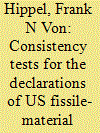

|
|
|
|
|
| Publication |
2011.
|
| Summary/Abstract |
In the 1970s and early 1980s, the United States Government released data on the history of its purchases of natural uranium, the amount of separative work done by U.S. uranium enrichment plants, and the fission energy released by U.S. production reactors. These data provided the basis of nongovernmental estimates in the 1980s of U.S. production of plutonium and highly enriched uranium. In 1996 and 2006, the United States published reports on its historical production of plutonium and highly enriched uranium respectively. This article presents a first rough analysis of the two sets of data and finds that they are reasonably consistent.
|
|
|
|
|
|
|
|
|
|
|
|
|
|
|
|
| 3 |
ID:
157471


|
|
|
|
|
| Summary/Abstract |
In 2013, the staff of the U.S. Nuclear Regulatory Commission estimated the reduction of the off-site economic losses from a fire in a drained U.S. spent fuel pool if fuel that had cooled for more than five years were transferred to dry cask storage--an option it called "expedited transfer." In this article, it is shown that the savings would be much higher than the NRC estimated. Savings increase to about $2 trillion if: losses beyond 50 miles are included; the land-contamination threshold for long-term population relocation is changed to that used for the Chernobyl and Fukushima accidents and recommended by the U.S. Environmental Protection Agency; and, based on the experience of Japan, decontamination of land areas to levels acceptable for population return is assumed to take at least four years. If expedited transfer were implemented, the off-site economic losses would be reduced by about 98%.
|
|
|
|
|
|
|
|
|
|
|
|
|
|
|
|
| 4 |
ID:
067765
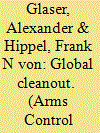

|
|
|
| 5 |
ID:
177840
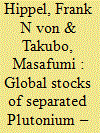

|
|
|
|
|
| Summary/Abstract |
With the end of the Cold War, Russia, the United States, France, and the United Kingdom declared an end to their production of plutonium for weapons and Russia and the United States declared large quantities excess to their future weapon requirements. The disposal of these excess stocks has stalled, however, and during the next two decades, the relatively small stocks of weapons plutonium in India, North Korea, Pakistan and possibly also China could increase significantly. Meanwhile, despite the failed commercialization of plutonium breeder reactors, the separation of civilian but weapon-usable plutonium from power-reactor fuel continues in France, India, Japan, Russia, and has begun in China. The global stock of separated civilian plutonium now exceeds that of weapons plutonium and could increase further during the next two decades.
|
|
|
|
|
|
|
|
|
|
|
|
|
|
|
|
| 6 |
ID:
065420
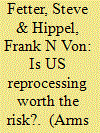

|
|
|
| 7 |
ID:
080856


|
|
|
| 8 |
ID:
074997


|
|
|
| 9 |
ID:
076777


|
|
|
|
|
| Publication |
2007.
|
| Summary/Abstract |
In February 2006, the Department of Energy (DOE) released its historical account of U.S. production and disposition of highly enriched uranium (HEU) through 1996. The report was unclassified and had been completed in 2001, but it required five years of petitions and appeals under the Freedom of Information Act (FOIA) before the Bush administration was forced to release it. According to the report, in 1996 the United States had a stockpile of 741 metric tons (MT) of HEU with an average enrichment of 84 percent. Of that stockpile, 178 MT of HEU with an average enrichment of 62 percent had been declared excess for military purposes. In 2005 and 2006, an additional 70 MT was declared excess and 138 MT was put into a reserve for future use as naval reactor fuel. An estimated 5 MT of HEU was lost due to "normal operating losses," and there was a residual discrepancy of about 3 MT between the number obtained by subtracting cumulative disposition from cumulative production and the actual 1996 stockpile. This article discusses the value of this information and provides insights about the feasibility of declaring additional U.S. weapons HEU excess and the ultimate limits of nuclear disarmament verification
|
|
|
|
|
|
|
|
|
|
|
|
|
|
|
|
|
|
|
|
|